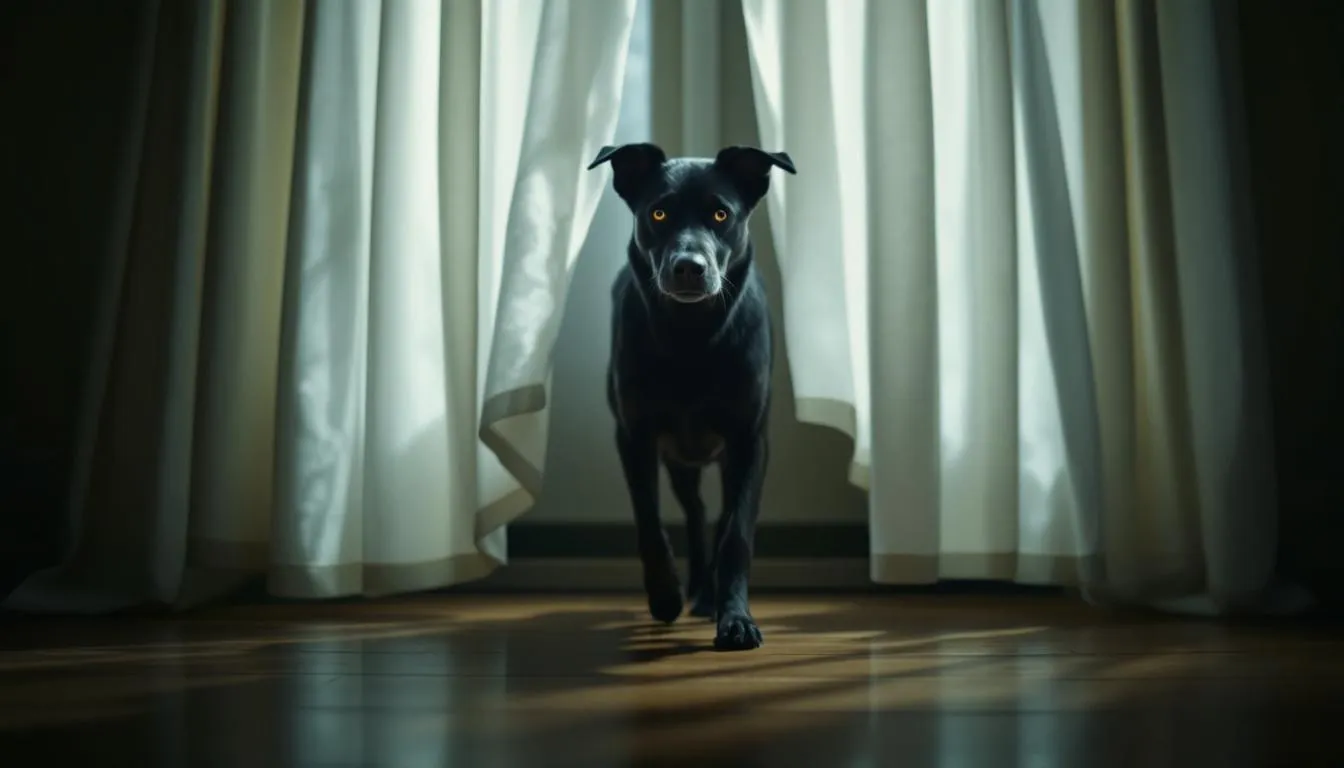Key Takeaways
- Dog trancing is a harmless behavior where dogs walk extremely slowly under hanging objects like plants or curtains
- Also known as Trance-like Syndrome (TLS), ghost walking, or weed walking, this behavior is not a seizure or medical emergency
- Dog trancing is not the same as atypical seizures; while some behaviors may look similar, trancing is usually harmless and not related to neurological issues like atypical seizures
- Certain breeds like Bull Terriers, Greyhounds, and other sighthounds are more prone to trancing behavior
- Dogs remain responsive during trancing and can be easily interrupted by calling their name
- While generally harmless, sudden onset in elderly dogs or excessive trancing may warrant veterinary consultation
Dog trancing is a harmless behavior where dogs walk extremely slowly under hanging objects like plants or curtains
Also known as Trance-like Syndrome (TLS), ghost walking, or weed walking, this behavior is not a seizure or medical emergency
Dog trancing is not the same as atypical seizures; while some behaviors may look similar, trancing is usually harmless and not related to neurological issues like atypical seizures
Certain breeds like Bull Terriers, Greyhounds, and other sighthounds are more prone to trancing behavior
Dogs remain responsive during trancing and can be easily interrupted by calling their name
While generally harmless, sudden onset in elderly dogs or excessive trancing may warrant veterinary consultation
You’re relaxing at home when you notice your dog moving like they’re underwater—each step deliberate, slow, and almost dreamlike as they walk beneath your hanging plant. Their eyes appear glassy, distant, as if they’ve entered another world entirely. If you’ve witnessed this strange behavior, you’re not alone, and more importantly, you’re likely not looking at a medical emergency.
This fascinating phenomenon, known as dog trancing or called trance like syndrome (TLS), affects many dogs across various dog breeds. While it might look concerning at first glance, this odd behavior is typically perfectly normal and harmless. Understanding what’s happening when dogs trance can help put worried pet parents at ease and ensure your furry friends stay safe during these mysterious episodes.


What is Dog Trancing?
Dog trancing, formally known as trance like syndrome (TLS), describes a specific behavior where dogs move with an extremely slow, deliberate gait under low hanging objects. During these episodes, your dog moves so slowly it almost appears they’re walking in slow motion, displaying what veterinarians call a “hypokinetic gait”—a technical term for exceptionally measured, soft footfalls. Many dogs have been observed as they walked in a trance-like manner beneath these objects, further emphasizing the hypnotic quality of the behavior.
When your pup enters this trance like state, you’ll notice several distinctive physical signs. Their ears typically flatten against their head, their nose points upward, and their eyes often appear squinted or glassy. The dog’s gaze becomes fixed and distant, creating that unmistakable “far away” appearance that gives this behavior its name.
These trancing episodes can last anywhere from a few seconds to around 30 minutes, though most episodes are much shorter. Dogs may pause mid-walk, remaining completely motionless for periods before continuing their ghost walking weed expedition. What’s particularly interesting is that dogs typically remain responsive during these episodes—you can usually snap them out of it simply by calling their name, though they might appear slightly annoyed at the interruption.
The behavior goes by several names in pet communities. Some dog owners call it ghost walking, others refer to it as weed walking, and veterinary professionals use the formal term trance like syndrome. Regardless of what you call it, the behavior itself remains consistent: that characteristic slow, deliberate movement under hanging objects that lightly touches your dog’s back or head. Certain objects, such as specific fabrics or textures, are more likely to trigger trancing episodes in some dogs.


Why Do Dogs Trance?
The exact cause behind why dogs trance remains one of those delightful mysteries in canine behavior. Current research suggests the light brushing sensation of leaves, fabric, or other hanging objects against your dog’s back may trigger feelings of calm and happiness. This tactile stimulation appears to create a pleasurable sensory experience that some dogs actively seek out.
Many dog experts theorize that trancing behavior might connect to ancestral behaviors inherited from wild canine ancestors. In the wild, moving slowly through dense vegetation while hunting or exploring would have been advantageous, allowing animals to move stealthily without alerting prey or predators. This learned behaviour may have evolved into the ritualistic trancing we observe in domestic dogs today.
Some veterinarians suggest a possible connection between dog trancing and canine compulsive disorder, particularly in dogs that also exhibit other repetitive behaviors like tail chasing. However, it’s important to note that trancing itself is not classified as obsessive compulsive disorder or compulsive disorder. Unlike true ocd behaviors, trancing episodes are typically infrequent and don’t interfere with your dog’s normal daily activities.
The behavior appears to be apparently purposeless from a practical standpoint, yet dogs seem to derive genuine pleasure from these episodes. This suggests that trancing serves some form of sensory or emotional regulation for certain dogs. The fact that dogs often seek out specific household items or low hanging branches to repeat the behavior supports the theory that this is an intentional, self-soothing activity.
What’s particularly fascinating is that this behavior is spontaneous rather than learned from other dogs. A second dog in the household won’t necessarily pick up trancing behavior from watching their housemate, suggesting there may be individual neurological or sensory factors that predispose certain dogs to this unusual habit.
Triggers and Stimuli: What Sets Off Trancing?
Have you ever noticed your dog suddenly slow down and move with almost hypnotic precision beneath a dangling tablecloth or a low-hanging branch? For many pet parents, this ghost walking or weed walking behavior can seem mysterious, but understanding what sets off trancing can help you better manage your furry friend’s odd habits.
Dog experts agree that the most common trigger for trancing is the gentle touch of low hanging objects—like curtains, plants, or even your favorite throw blanket—brushing against your dog’s back or head. This light, almost tickling sensation can send certain breeds, especially Bull Terriers and Greyhounds, into a trance like state. The dog’s movements become slow and deliberate, as if they’re savoring every second of the experience.
While the sensation of touch is the primary catalyst, some dogs may also be influenced by specific textures, subtle sounds, or even unique smells in their environment. These sensory cues can prompt trancing episodes, especially in dogs that are naturally more sensitive or prone to repetitive behaviors. For example, dogs with a history of tail chasing or other ocd behaviors may be more likely to develop trancing behavior, particularly if they are already inclined toward apparently purposeless or ritualistic actions.
It’s important for dog owners to pay attention to what seems to trigger their pet’s trancing. By observing when and where these episodes occur, you can better manage dog trancing and ensure your pet’s environment is safe. Most of the time, trancing is a perfectly normal and harmless behavior, but if you notice other symptoms—such as seizure activity, sudden changes in behavior, or signs of neurological issues—it’s wise to consult your veterinarian. These could indicate underlying medical conditions that need attention.
For the vast majority of dogs, trancing is simply one of those quirky, endearing habits that make your pet unique. As long as your dog seems happy and healthy, there’s usually no cause for concern. However, if you ever feel worried about your dog’s strange behavior or notice it becoming more frequent or intense, don’t hesitate to reach out to a veterinary professional. With a little observation and care, you can help your furry friend enjoy their trance like moments safely and comfortably.


Breeds Most Prone to Trancing
While dog trancing can theoretically occur in any breed or mixed breed, certain dog breeds show a significantly higher predisposition to this behavior. Bull terriers top the list, with this breed showing the highest documented incidence of trance like syndrome. If you own a Bull Terrier who trances, you’re part of a well-documented phenomenon that’s been observed in this breed for decades.
Sighthound breeds also commonly exhibit trancing behavior. Greyhounds, Salukis, and Whippets are frequently mentioned in discussions about ghost walking weed behavior. These breeds, originally developed for hunting and coursing, may retain some ancestral connection to the slow, deliberate movement patterns observed during trancing episodes.
Dogs with existing canine compulsive disorder tendencies, particularly those prone to tail chasing or spinning behaviors, appear more susceptible to developing trancing habits. However, it’s crucial to understand that trancing itself is not considered a compulsive disorder—it’s simply more commonly observed in dogs that exhibit other repetitive behaviors.
The apparent genetic component influencing the occurrence of these trance like behaviors suggests that breeding lines within certain breeds may carry a predisposition to trancing. However, no breed is completely immune to this quirky canine behavior. Many mixed breeds and dogs from breeds not typically associated with trancing have been documented displaying this odd behavior.
Interestingly, age and sex don’t appear to significantly influence trancing behavior. Both male and female dogs can develop this habit, and while it’s more commonly first observed in adult dogs, some younger animals also display trancing tendencies as they mature.
Dog Trancing vs. Seizures: Key Differences
One of the primary concerns dog owners face when first witnessing trancing behavior is whether they’re observing seizure activity. This worry is completely understandable—watching your beloved pet move in such an unusual manner can be alarming. However, several key differences clearly distinguish harmless trancing from serious neurological issues. Some experts have considered whether trancing could be related to atypical seizures, which can cause altered mental activity and odd behaviors in dogs. However, current evidence suggests that trancing is usually harmless and distinct from both typical and atypical seizure disorders.
The most significant difference lies in responsiveness. Dogs experiencing trancing episodes remain aware of their surroundings and can be easily interrupted by calling their name or gentle touch. In contrast, dogs having even a seizure typically lose consciousness and cannot respond to external stimuli during the episode.
After a seizure, dogs experience what veterinarians call a postictal phase—a period of confusion, disorientation, and often exhaustion. Dogs who have just finished a trancing episode show no such confusion. They immediately return to normal behavior, sometimes appearing slightly annoyed if you interrupted their peaceful ghost walking session.
Current research confirms that anti-seizure medications do not prevent trancing behavior, further supporting the distinction between TLS episodes and actual seizure activity. Additionally, dogs experiencing seizures often show other symptoms like tremors, loss of bladder or bowel control, drooling, or collapse—none of which are associated with normal trancing behavior.
Veterinarians emphasize that dogs maintain complete awareness during trancing episodes. They may respond slowly or appear reluctant to end their trance like state, but they can be roused and will typically walk away normally once interrupted. This responsiveness is perhaps the most reassuring sign that what you’re witnessing is harmless trancing rather than a medical emergency.


When to Consult a Veterinarian
While occasional trancing in otherwise healthy dogs requires no veterinary intervention, certain circumstances warrant professional evaluation. Understanding when to be concerned versus when to simply document this charming quirk can help you make informed decisions about your dog’s health.
Most veterinarians agree that typical trancing behavior—occasional episodes lasting minutes rather than hours, with easy interruption and no other symptoms—poses no health concerns. However, you should seek veterinary advice if your dog shows excessive zoning out, prolonged unresponsiveness, or if trancing becomes compulsive rather than occasional.
Warning signs that indicate potential underlying medical conditions include aggression during or after episodes, head pressing against walls or objects, tremors, vomiting, drooling, or collapse. These symptoms suggest possible neurological issues that extend beyond normal trancing behavior and require immediate veterinary attention.
Sudden onset of frequent trancing in elderly dogs should also prompt a veterinary hospital visit. While trancing can develop at any age, dramatic changes in behavior patterns—especially in senior pets—sometimes indicate underlying health changes that deserve professional evaluation.
When documenting episodes for your veterinarian, try to record the frequency, duration, and any triggers you notice. Video documentation can be particularly helpful, allowing your vet to see exactly what behavior you’re observing. This information helps differentiate between normal trancing and other symptoms that might require investigation.
Safety considerations are also important when managing dog trancing episodes. Ensure that any hanging objects your dog uses for trancing are safe and non-toxic. Avoid allowing trancing under poisonous plants, unstable objects, or in dangerous locations. Your pet’s safety during these vulnerable moments should always be the top priority.
How to Manage Dog Trancing
Managing your dog’s trancing behavior is generally straightforward since this odd behavior rarely requires intervention. If you catch your dog in the middle of a trancing episode, it’s best to let them finish unless safety is a concern. The key principle for most pet parents is simple: allow your dog to complete their trancing ritual naturally, as it appears to provide genuine comfort and enjoyment.
Avoid scolding or punishing this perfectly normal behavior. Your dog isn’t misbehaving or doing anything wrong—they’re simply engaging in a quirky habit that brings them pleasure. Interrupting occasionally for safety reasons is fine, and calling your pup's name is usually enough to end the trance immediately. However, making trancing feel forbidden or stressful defeats the purpose of what appears to be a self-soothing activity.
Monitor the surroundings to ensure safety during trancing episodes. Remove or secure any hazardous household items that might pose risks if your dog moves slowly beneath them. Check that low hanging objects are stable and won’t fall if bumped, and ensure any plants your dog favors for weed walking are non-toxic.
Recording episodes can be valuable for veterinary reference during routine wellness visits. Many vets appreciate seeing videos of the behavior, especially if it’s your dog’s first time displaying trancing tendencies. This documentation helps establish a baseline for what’s normal for your individual pet.
Trust your instincts about when behavior seems concerning versus harmless. Most dog owners develop a good sense of their pet’s normal patterns and can recognize when something feels “off.” If you’re worried, don’t hesitate to contact your vet—peace of mind is worth a consultation.
Should You Discourage Trancing?
The simple answer is no—trancing behavior doesn’t need to be discouraged by concerned pet parents. This harmless quirk typically occurs infrequently, with most dogs’ trancing episodes happening weekly to every few months rather than daily. The behavior is generally occasional rather than compulsive or obsessive.
Dogs rarely become obsessed with trancing in ways that interfere with their normal activities. They maintain healthy balance with regular play, exercise, social interaction, and other aspects of their dog’s life. Unlike true compulsive behaviors that can become problematic, trancing usually remains a minor, occasional habit.
Understanding and accepting this behavior helps create a more relaxed household where your pet feels free to engage in natural, harmless activities. Many dog owners actually find their pet’s trancing episodes endearing once they understand the behavior is normal and safe.
FAQ
Can dog trancing become dangerous?
Trancing itself is harmless, but ensure your dog isn’t trancing near poisonous plants, toxic substances, or in unsafe locations like near traffic or cliffs.
How long should I let my dog trance before interrupting?
There’s no set time limit—dogs naturally end trancing sessions on their own. You can safely interrupt by calling their name if needed for safety reasons.
Is trancing more common in certain weather conditions?
While not scientifically proven, some pet parents report increased trancing during calm, mild weather when dogs spend more time outdoors under vegetation.
Can puppies exhibit trancing behavior?
Trancing typically develops in adult dogs rather than puppies, though young dogs can occasionally display this behavior as they mature.
Will my dog outgrow trancing behavior?
Most dogs who trance continue this behavior throughout their lives, though frequency may change with age. It’s considered a lifelong quirk rather than a phase.
FAQ
Can dog trancing become dangerous?
Trancing itself is harmless, but ensure your dog isn’t trancing near poisonous plants, toxic substances, or in unsafe locations like near traffic or cliffs.
How long should I let my dog trance before interrupting?
There’s no set time limit—dogs naturally end trancing sessions on their own. You can safely interrupt by calling their name if needed for safety reasons.
Is trancing more common in certain weather conditions?
While not scientifically proven, some pet parents report increased trancing during calm, mild weather when dogs spend more time outdoors under vegetation.
Can puppies exhibit trancing behavior?
Trancing typically develops in adult dogs rather than puppies, though young dogs can occasionally display this behavior as they mature.
Will my dog outgrow trancing behavior?
Most dogs who trance continue this behavior throughout their lives, though frequency may change with age. It’s considered a lifelong quirk rather than a phase.






